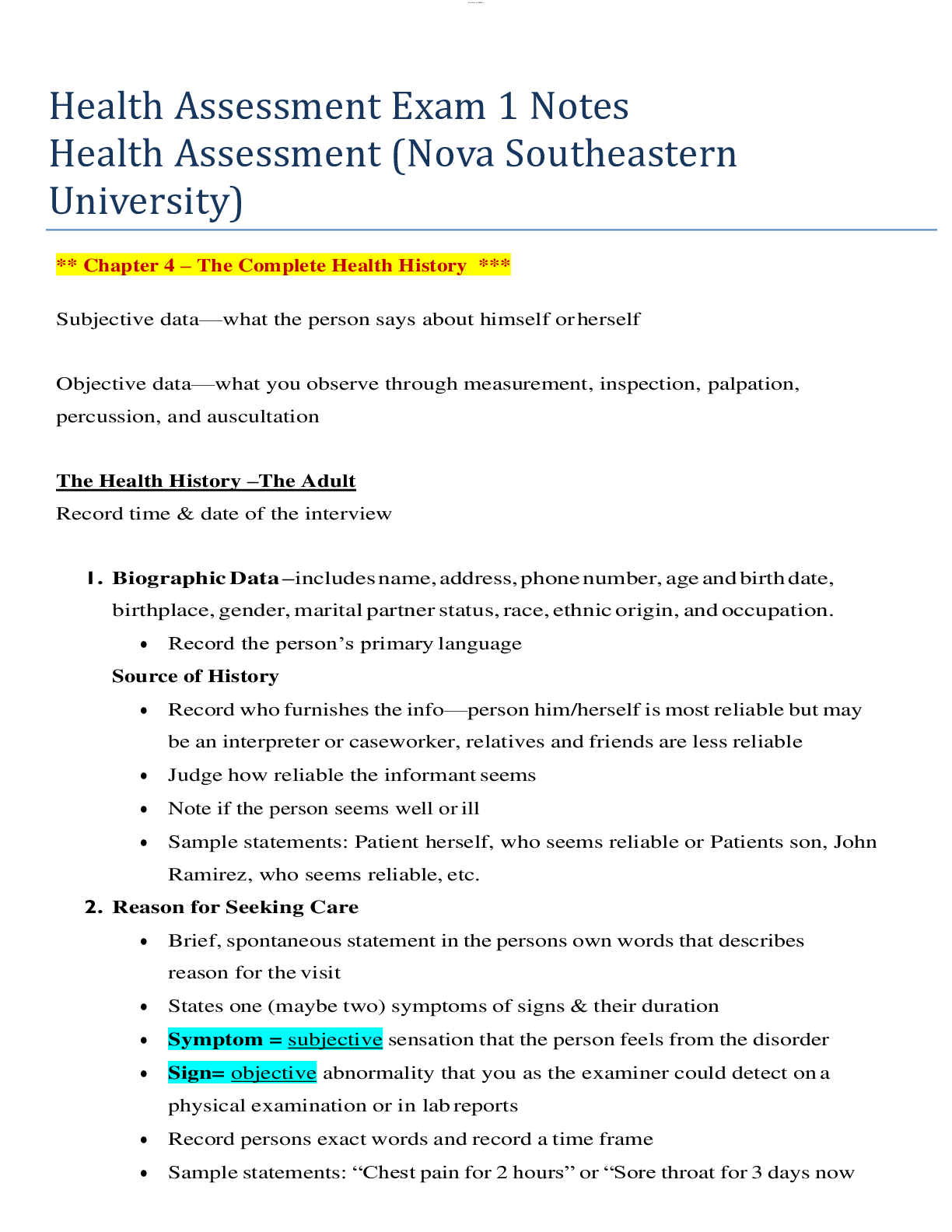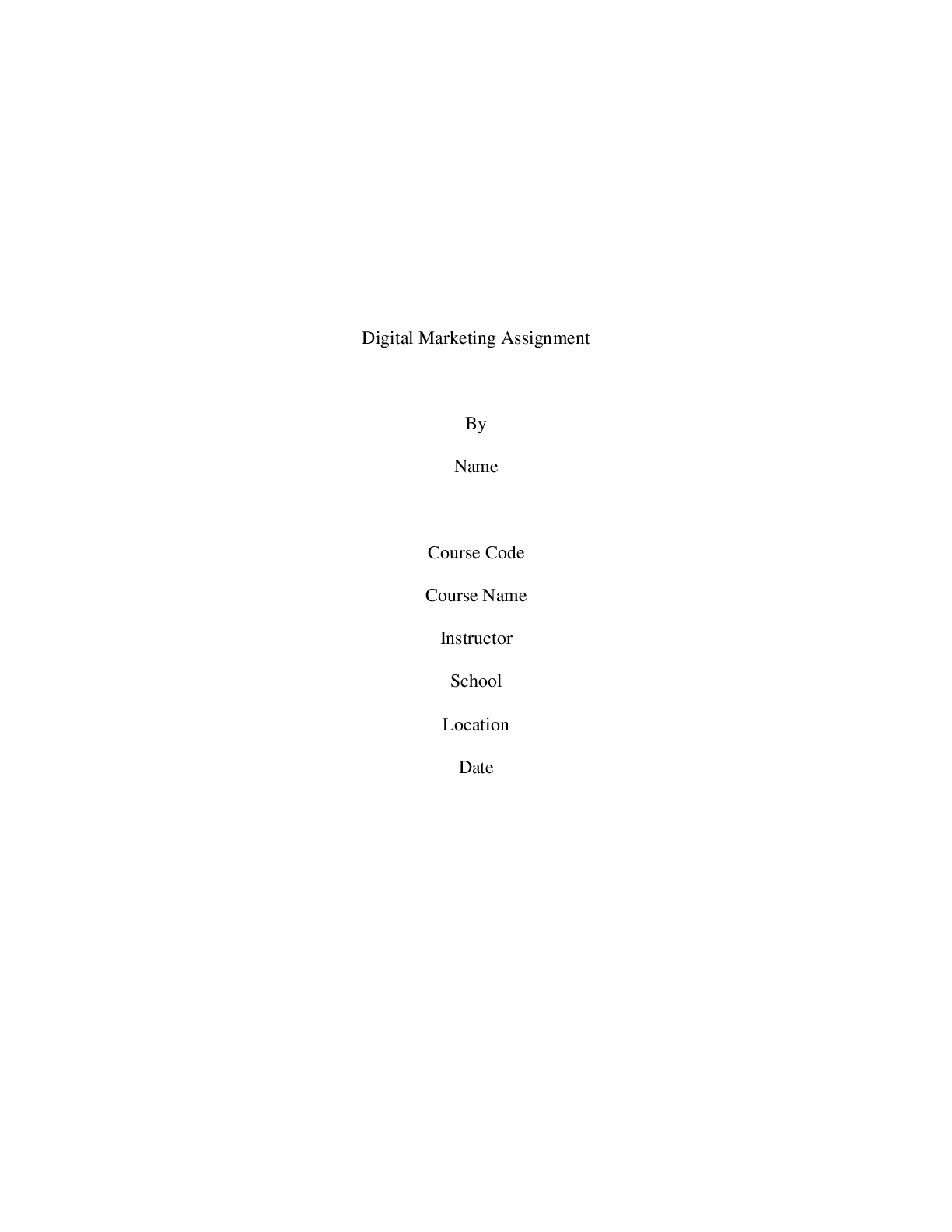Labour Law > Class Notes > Pennsylvania State University: LESSON 1-13: Study notes for LER 136, LER 401, LER 201, LER 312 - LE (All)
Pennsylvania State University: LESSON 1-13: Study notes for LER 136, LER 401, LER 201, LER 312 - LER 312/LER 100, LER 424, and LER 425
Document Content and Description Below
THE STUDY NOTES ATTACHED CONTAINS ALL LESSONS 1 TO LESSON 13 LER 136 - Race/Gender/Employment/ LER 401 - Labor-Management Relations Law/LER 201 - Employment Relationship: Law and Policy/LER 312 - L... ER 312/LER 100 - Employment Relations LER100/ LER 424 - Employee Compensation/ LER 425 - Employee Benefits/ Lesson 01: Employment Law Constitutional Separation of Powers Statutes, Regulations, and Executive Orders Statutes are what people think of when they are talking about a "law." A statute is a written law enacted by the United States Congress or by a state legislature. Examples: the Age Discrimination in Employment Act (ADEA), Title VII of the Civil Rights Act of 1964 (Title VII), and the Pennsylvania Wage Payment and Collection Law Example: Employment-law regulations include the federal regulations issued by the United States Department of Labor interpreting the application of the Family Medical Leave Act (FMLA). Example: Executive Order 11246, which was issued in 1965 by President Lyndon B. Johnson and requires federal contractors not to discriminate in the hiring, promotion, pay and working conditions, and discharge of their employees based on race, color, religion, gender, or national origin Ordinances and Case Law Enforcing Employment-Law Rights EEOC Investigation and Enforcement Actions For more information on how to file Employment Discrimination charges visit: https://www.eeoc.gov/employees/charge.cfm Court Enforcement of Employment Law Claims Steps in a Typical Court Case Appellate Court Cases WA, MT, ID, AZ, Guam and the Mariana Island. http://www.uscourts.gov/court-locator Use of Published Court Decisions in Resolving Employment-Law Issues Lesson 02: Employment Relationships The Employer–Employee Relationship Why Use Employees Rather Than Independent Contractors? Mischaracterization of Employees as Independent Contractors Distinguishing Employees from Independent Contractors 1. Determine the applicable law; in this case it is the unemployment-compensation statute for the state of Pennsylvania. At-Will Employment and Exceptions to the At-Will Doctrine Exceptions to the At-Will Doctrine: Wrongful Discharge 1. Discharge in violation of public policy 2. Discharge in violation of an implied covenant of good faith and fair dealing 3. Discharge in breach of an implied contract 4. Tortious discharge Discharge in Violation of Public Policy Discharge in Violation of an Implied Covenant of Good Faith and Fair Dealing Discharge in Breach of an Implied Contract Tortious Discharge Worker Adjustment and Retraining Notification Act (WARN) Lesson 03: Introduction to Discrimination Introduction Basics of Title VII Title VII of the Civil Rights Act of 1964 is a comprehensive federal statute that makes it unlawful for an employer to hire or discharge any individual, or Title VII Coverage Employees of Small Employers Statute of Limitations More information on mediation as used by the EEOC can be found at: https://www.eeoc.gov/employees/mediation.cfm Anti-Retaliation Provisions of Title VII https://www.eeoc.gov/laws/types/retaliation.cfm Theoretical Bases for Discrimination Claims Defenses to Discrimination Claims under Title VII Lesson 04: Race and Color Discrimination Discrimination Based on Color or Race EEOC has also set forth guidelines on the differences of race, color and national origin. See: https://www.eeoc.gov/eeoc/initiatives/e-race/ https://www.eeoc.gov/policy/docs/race-color.html https://www.eeoc.gov/laws/types/race_color.cfm Circumstantial evidence and the McDonnell Douglas Case Disparate Impact Based on Race Protection for Opposing Unlawful Race Discrimination Harassment Based on Race and Discrimination Based on Color Harassment Based on Race Discrimination Based on Color Other Laws Prohibiting Race and Color Discrimination Federal Laws State Laws Affirmative Action: Effective or Not? Executive Order 11246: Affirmative Action as a General Remedy Affirmative Action as a Court-Imposed Remedy for Discrimination Lesson 05: Gender Discrimination Introduction Gender Discrimination The following site will provide you with the statistical information on the number of cases filed with the EEOC from 1992–to present: https://www.eeoc.gov/laws/types/sex.cfm https://www.eeoc.gov/eeoc/statistics/enforcement/sex.cfm Statutory Prohibitions against Gender Discrimination in Employment Title VII Protections Example: A female employee is denied promotion. First, to establish a prima facie case, the employee proves (1) that she is a member of a protected class--female; (2) that she is qualified for the promotion; (3) that despite her qualification, she is rejected; and (4) that the employer promotes a male instead of her. At this point, the employer must articulate a non-discriminatory reason for its decision, such as that the male employee had better educational qualifications for the promotion. Finally, the female employee must prove that the employer's stated reason for her rejection was pretextual. She can do this by proving that the educational qualification of the male employee had nothing to do with the ability to perform the job to which he has been promoted and the employer knew it. Title VII Protections: Gender-Stereotyping Cases "Gender-Plus" Discrimination Cases Gender Discrimination Based on Customer or Employee Preferences "Logistical-Problems" Gender-Discrimination Cases Title VII Protections: Fetal-Protection Cases Comparable Worth The Pregnancy Discrimination Act Family and Medical Leave Act Provisions Related to Childbirth Detailed information about the FMLA can be found at the following link. https://www.dol.gov/whd/fmla/ Lesson 06: Sexual Harassment Introduction The Statutory Basis for Sexual Harassment Types of Sexual Harassment Hostile Environment: Unwelcome Conduct Example: A female claims that she was harassed by male employees constantly telling sexually explicit jokes in her presence at the workplace, but the employer is able to provide evidence that the female employee herself often told her own sexually explicit jokes to male employees. Hostile Environment: Gender Based Hostile Environment: Severe and Pervasive Hostile Environment: Affecting Term, Condition, or Privilege of Employment Hostile Environment: Employer Knowledge and Failure to Prevent or Correct Defense to Sexual Harassment Claims Lesson 07: Religious and National-Origin Discrimination Introduction Religious Discrimination When Is an Employee Entitled to Protection Based on His Religion? The Employer's Duty of Reasonable Accommodation Practical Suggestions Concerning Reasonable Accommodation of Religious Beliefs and Practices Religious Harassment National-Origin Discrimination Immigration Reform and Control Act of 1986. The Scope of Title VII's Protections Based on National Origin Issues Raised by English-only Rules National Origin and the IRCA Harassment based on National Origin The IRCA and National Origin Discrimination National-Origin Discrimination Claims Under 42 U.S.C. Section 1981 Lesson 08: Other Types of Discrimination Introduction Age Discrimination Similarities between the ADEA and Title VII Hostile Environment Based on Age-- Differences Between the ADEA and Title VII Waivers of Age-Discrimination Claims Older Workers' Benefit Protection Act (OWBPA). Final Note on Age Discrimination Discrimination Based on Affinity Orientation Affinity orientation Constitutional Prohibitions Against Affinity Orientation Discrimination Harassment Based on Affinity Orientation Military and Veterans Status Discrimination Uniformed Services Employment and Reemployment Rights Act of 1994 (USERRA). Whistleblower Protections Lesson 09: Disabilities Discrimination Introduction Disabilities Discrimination Protections Provided by the ADA Proving Discrimination Based on a Disability under the ADA and the Rehabilitation Act To prove a case for discrimination based on disability, the individual claiming discrimination must meet each criteria to prove the case. These criteria are essentially as follows: A. Is the individual "disabled," as defined in the ADA? Does she have an impairment that substantially limits a major life activity? B. Apart from her disability, is the individual qualified for her position with the employer? C. If the individual is only qualified for her position with the employer through the employer providing her with an accommodation, is the accommodation reasonable or does it impose an undue hardship on the employer? D. Has the individual suffered an adverse employment action? See also https://www.eeoc.gov/laws/types/disability.cfm Is the individual disabled? 1. Having a physical or mental impairment that substantially limits one or more of the major life activities of an individual. 2. Having a record of a disability 3. Being regarded as having a disability Is the individual "otherwise qualified" for the position? Individuals posing a Direct Threat to health and safety are not considered otherwise qualified. Does the individual require a reasonable accommodation to be qualified for a position? Did the individual suffer an adverse employment decision? Lesson 10: Labor Law Introduction Private Sector Labor Law The National Labor Relations Act of 1935 Selecting a Labor Organization for Representation Subjects Appropriate for Collective-Bargaining Negotiations Regulating How Employers and Unions Conduct Collective Bargaining Illegal Conduct Under the NLRA The Taft-Hartley Act of 1947 The Landrum-Griffin Act of 1959. Public-Sector Labor Law Lesson 11: Benefits, Pensions, and Leaves of Absence Introduction Regulation of Pensions and Fringe Benefits Coverage of ERISA Specific Regulatory Requirements of ERISA Significant Amendments to ERISA: SARBANES-OXLEY and COBRA 2. Consolidated Omnibus Budget Reconciliation Act of 1985 (COBRA). Significant Amendments to ERISA: HIPAA Regulation of Leaves of Absences: The Family and Medical Leave Act (FMLA) Employer Coverage and Employee Eligibility Situations that Trigger Employer Obligations to Grant FMLA Leave Paid Leave under the FMLA Intermittent Leave Reinstatement and Fringe Benefit Rights of Employees Who Take FMLA Leave How Does an Employee Go About Taking FMLA Leave? Administrative Requirements of the FMLA Enforcement of the FMLA and Remedies for Violations Lesson 12: Wages, Hours, Employment of Aliens, and Privacy Introduction Regulation of Employee Wages and Hours: Fair Labor Standards Act (FSLA) Minimum Wage Requirements Overtime Premium Requirements Child-Labor Restrictions Equal Pay Act Requirements Other Aspects of the FLSA Employment of Aliens in the United States Employee Privacy Law Public-Sector Privacy Protections Constitutional Protections Federal Statutory Protections--The Privacy Act of 1974 State Constitutional Protections Private-Sector Emplo yee Privacy Protections Private-Sector Employee Privacy Protections, continued Special Privacy Issues: Electronic Communications Title III of the Omnibus Crime Control and Safe Streets Act of 1968, Lesson 13: Workplace Regulation Introduction Policy Considerations Underlying Both the Occupational Safety and Health Act and Workers' Compensation Laws The Occupational Safety and Health Act The Basic Requirements of OSHA National Institute for Occupational Safety and Health The Basic Requirements of OSHA, continued Hazard-Communication Standards Enforcement of OSHA and Penalties for Violations Employer Defenses Workers' Compensation Statutes The Philosophical Bases of Workers' Compensation Laws Making Claims under Workers' Compensation Statutes Ensuring Financial Responsibility for Workplace Injuries: Workers' Compensation Insurance Special Issues in Workers' Compensation Law Avoiding Legal Claims Based on Workplace Safety Violations and Injuries [Show More]
Last updated: 2 years ago
Preview 1 out of 163 pages

Buy this document to get the full access instantly
Instant Download Access after purchase
Buy NowInstant download
We Accept:

Reviews( 0 )
$5.00
Can't find what you want? Try our AI powered Search
Document information
Connected school, study & course
About the document
Uploaded On
May 02, 2020
Number of pages
163
Written in
Additional information
This document has been written for:
Uploaded
May 02, 2020
Downloads
0
Views
112














